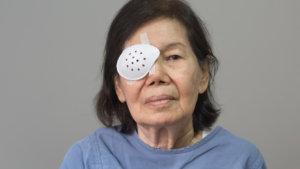
A safe treatment with a low incidence of problems, phacoemulsification cataract surgery is becoming the standard approach for treating cataracts today. The vast majority of patients have a considerable improvement in their eyesight after a quick, painless operation that is conducted on an outpatient basis. However, while problems following cataract surgery are extremely rare, they can occur and have a negative impact on the patient’s eyesight. It is suggested that patients be evaluated the next day after the cataract surgery since many of these issues are visible the day after the procedure. Any problems that are discovered can then be addressed in a timely way, allowing for appropriate healing and recovery to take place.
Transient complications: These are typically signs that medical attention is needed.
Ocular edema (blurred vision) can occur as a result of surgical trauma, notably the ultrasonic energy and the fluid flowing into the anterior chamber. While the endothelial cells are working to remove the water from the corneal stroma, the vision will be obscured until the water is removed. Because of the use of high-quality viscoelastic materials, corneal edema is less prevalent; nonetheless, prolonged cataract surgery brisbane on a dense nucleus may result in localized or, in some cases, widespread corneal swelling. Controlling inflammation with steroids, as well as the use of a hypertonic saline solution, can aid to expedite the restoration of sight.
High intraocular pressure (IOP)

For the majority of patients, the IOP should be within physiologic limits. Because of residual viscoelastic, it might be greater or lower depending on whether an incision has been made. High intraocular pressure (IOP) can be treated medically using topical and oral medications, and the patient should be continuously monitored. Pressure normally returns to normal when the viscoelastic has been cleared from the anterior chamber. Tapping the anterior chamber to release aqueous is not usually advised due to the fact that this method is normally only a short-term remedy and exposes the eye to an elevated risk of infection.
It is typical to see a degree of anterior chamber cells and flare the day after the cataract surgery because surgical procedures always generate some degree of inflammation. If you experience an unusually strong anterior chamber reaction with fibrin or a hypopyon, this is not normal and may indicate inflammation caused by toxic anterior shock syndrome or perhaps endophthalmitis. Both require periodic steroid administration to keep the inflammation under control, however, the latter requires a diagnostic tap, antibiotic injection, and immediate action to keep the vision and the eye from being permanently damaged. Even though the normal appearance of endophthalmitis occurs many days after the cataract surgery, it can occur as early as the first postoperative day.
Anatomic complications: a sign that surgical intervention is required

Phacoemulsification can result in the retention of tiny cataract fragments in the anterior chamber. This occurs because the cataract is fragmented into several pieces during the procedure, and a small piece may remain in the anterior chamber. These cataract fragments have the potential to induce significant inflammation and localized harm to the cornea. When a little, wispy cortical piece is present, it can be treated medically with steroids and targeted application of the YAG laser to break it up into smaller fragments and raise the surface area to volume ratio, but bigger pieces will require surgical intervention. A pars plana lensectomy and vitrectomy are advised in cataract surgery instances where there has been a posterior capsule rupture and there are residual lens fragments in the vitreous. Referral to an experienced vitreoretinal specialist is recommended in cataract surgery situations.
Subluxation of the IOL:
If the IOL implant is not properly secured, it has the potential to slip out of its initial position and become subluxated. This is more typically found in cases where the lens was inserted into the ciliary sulcus as a result of a defect in the posterior capsule of the eyeball, rather than in other scenarios. While it is possible to see modest episodes of IOL subluxation, a major displacement of the IOL away from the visual axis should be treated surgically. This type of suture attachment can help to assure long-term stability and centration of the IOL in certain situations.
An incision with a leak:
It is possible that there is leaking from an incision if the IOP is low. The use of a fluorescein dye leakage test can assist to locate the source of the leak and assess the degree of the fluid leaking. An incision that has seen significant leaking is an indicator that a suture will almost certainly be necessary to heal the wound and avoid additional hypotony and the danger of infection. When there is a leaky incision, the iris frequently acts as a plug to assist close it, therefore the presence of iris tissue trapped inside an incision is an indicator that there is an issue with the incision.
Complications that last a long time
While many of the possible problems of cataract surgery may be identified on the first postoperative day, some take longer to manifest themselves. Retinal problems such as cystoid macular edema or retinal fractures are common following cataract surgery and might manifest themselves days or weeks after the procedure. Relative refractive errors can only be reliably determined after the capsular bag has closed and the IOL has been placed in its ultimate location, which takes time. We may not even consider posterior capsule opacification to be a consequence of cataract surgery because it occurs so frequently and manifests itself weeks or months after the procedure.
Modern cataract surgery is a fantastic operation, but it still needs the involvement of an ophthalmologist throughout the process and thereafter. Ultimately, the final visual result for the patient is determined by both the surgical method and the healing process that occurs in the postoperative period.
Final thoughts
If you’re looking to manage the long-term complications of cataract surgery, this article will keep you well on track as regards making the right choices through your cataract surgery recovery process. You can read about Pre-surgical tips on how to manage cataracts by visiting http://healingsourcemed.com/pre-surgical-tips-on-how-to-manage-cataract/


